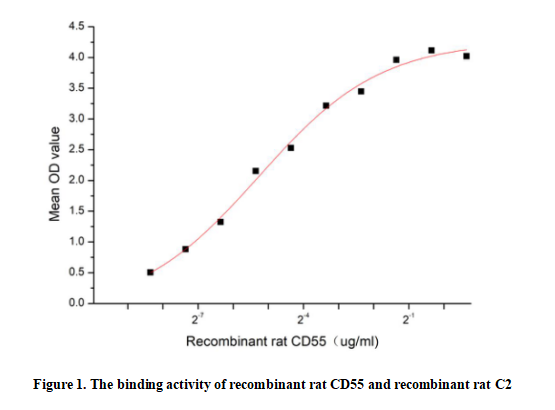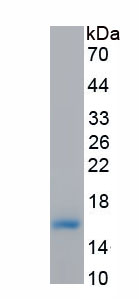Active Cluster Of Differentiation 55 (CD55) 

DAF; CR; TC; Complement decay-accelerating factor; Decay Accelerating Factor
- UOM
- FOB US$ 228.00 US$ 570.00 US$ 1,140.00 US$ 3,420.00 US$ 8,550.00
- Quantity
Overview
Properties
- Product No.APA468Ra01
- Organism SpeciesRattus norvegicus (Rat) Same name, Different species.
- ApplicationsCell culture; Activity Assays.
Research use only - DownloadInstruction Manual
- CategoryApoptosisImmune molecule
- Buffer FormulationPBS, pH7.4, containing 0.01% SKL, 5% Trehalose.
- Traits Freeze-dried powder, Purity > 90%
- Isoelectric Point11.0
Sign into your account
Share a new citation as an author
Upload your experimental result
Review

Contact us
Please fill in the blank.
Activity test

Cluster of Differentiation 55 (CD55), also known as Decay Accelerating Factor (DAF), is a glycosylphosphatidylinositol (GPI)-anchored membrane protein that belongs to the RCA (regulators of complement activation) family and is expressed on all cells that are bathed in plasma, such as blood cells and endothelial cells. CD55 functions as a complement regulator, accelerating the decay of C3 and C5 convertases, thereby inhibiting the formation of the membrane attack complex (MAC) and preventing complement-mediated cell lysis. It plays a crucial role in protecting host cells from complement damage and is involved in various physiological and pathological processes, including immune complex clearance and inflammation. Besides, Complement Component 2 (C2) has been identified as an interactor of CD55, thus a functional binding ELISA assay was conducted to detect the interaction of recombinant rat CD55 and recombinant rat C2. Briefly, CD55 was diluted serially in PBS with 0.01% BSA (pH 7.4). Duplicate samples of 100 μl were then transferred to C2-coated microtiter wells and incubated for 1h at 37℃. Wells were washed with PBST and incubated for 1h with anti-CD55 pAb, then aspirated and washed 3 times. After incubation with HRP labelled secondary antibody for 1h at 37℃, wells were aspirated and washed 5 times. With the addition of substrate solution, wells were incubated 15-25 minutes at 37℃. Finally, add 50 µL stop solution to the wells and read at 450/630 nm immediately. The binding activity of recombinant rat CD55 and recombinant rat C2 was shown in Figure 1, the EC50 for this effect is 0.026 ug/mL.
Usage
Reconstitute in 10mM PBS (pH7.4) to a concentration of 0.1-1.0 mg/mL. Do not vortex.
Storage
Avoid repeated freeze/thaw cycles. Store at 2-8°C for one month. Aliquot and store at -80°C for 12 months.
Stability
The thermal stability is described by the loss rate. The loss rate was determined by accelerated thermal degradation test, that is, incubate the protein at 37°C for 48h, and no obvious degradation and precipitation were observed. The loss rate is less than 5% within the expiration date under appropriate storage condition.
Increment services
-
 BCA Protein Quantification Kit
BCA Protein Quantification Kit
-
 Molecular Mass Marker for Protein
Molecular Mass Marker for Protein
-
 Monoclonal Antibody Customized Service
Monoclonal Antibody Customized Service
-
 Polyclonal Antibody Customized Service
Polyclonal Antibody Customized Service
-
 Protein Activity Test Experiment Service
Protein Activity Test Experiment Service
-
 Electrophoretic Mobility Shift Assay (EMSA) Experiment Service
Electrophoretic Mobility Shift Assay (EMSA) Experiment Service
-
 Buffer
Buffer
-
 Lentivirus Packaging Experiment Service
Lentivirus Packaging Experiment Service
-
 Adenovirus Packaging Experiment Service
Adenovirus Packaging Experiment Service
-
 Real Time PCR Experimental Service
Real Time PCR Experimental Service
-
 Spike RBD Protein (S-RBD)
Spike RBD Protein (S-RBD)
-
 Protein G
Protein G
-
 Protein A
Protein A
Citations
- Role of IL-1ra and Granzyme B as biomarkers in active Crohn's disease patientspubmed:28972805
- Clinical value of CD97 and CD55 levels in the differential diagnosis of tuberculous and malignant pleural effusions34397724







